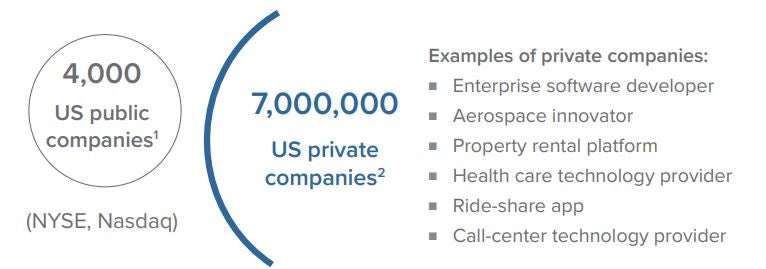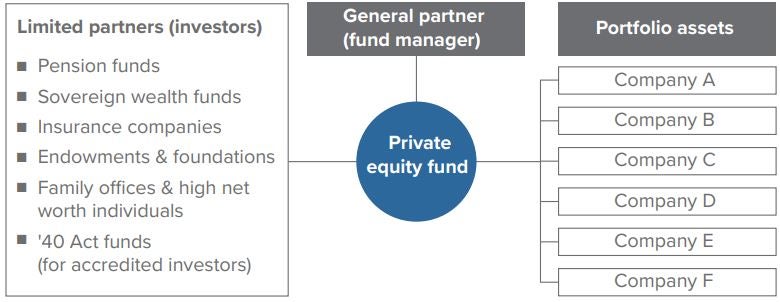The emergence of new investment vehicles has opened the private equity market to a wider range of investors.
Investing in the core of the American economy
Investors are familiar with buying stocks on exchanges like the Nasdaq or the New York Stock Exchange. But for every public company such as Amazon or Apple, there are a thousand privately held businesses seeking investor capital to grow.
There are seven million private incorporated businesses currently operating in the United States, a third of which employ at least 50 workers. These companies include some of the fastest growing and most disruptive startups, representing every major industry, from technology to manufacturing to retail.
Private equity, or “PE,” is how investors gain access to privately held companies.

1 Source: Nasdaq, as of 08/30/22.
2 Source: US Census Bureau, as of 2019 (released 02/11/22).
What is private equity?
Private equity is a type of investment in companies that are not publicly traded. In a typical deal, an investor buys a stake in a private company with the goal of realizing an increase in the value of the holding.
Private equity investment managers take an active role in the companies they acquire, providing expertise and resources to help drive growth and increase value, creating the potential for a significant return on investment.
PE managers have direct access to company management and can improve the profitability of portfolio companies.
Changes PE managers make include:
- Improve operations to enhance profit margins
- Accelerate revenue growth through the launch of new products or expansion into new markets
- Invest in accretive projects
- Improve the company’s management or market strategy and operating model
- Pursue acquisitions and mergers to enhance the company’s performance

How investors access private equity
Investors typically access private equity through funds that raise money to invest in private companies on behalf of their investors. These PE funds are typically organized as limited partnerships. Each investor is a limited partner (LP), while the PE firm acts as the general partner (GP), making investment decisions and managing the fund’s portfolio.

Source: Voya Investment Management and Pomona Capital. For illustrative purposes only.
Who can invest in private equity?
Historically, private equity has been an exclusive club for large institutional investors such as pension funds, sovereign wealth funds and insurance companies, many of which view private equity as a core component of a well-diversified portfolio. However, the emergence of new investment vehicles has opened the private equity market to a wider range of investors. These new vehicles address hurdles that have discouraged broader adoption in the past by lowering investment minimums, simplifying tax forms and offering regular liquidity.
If you’re interested in learning more, a financial advisor can help you understand how private equity may help you in the pursuit of long-term financial goals.

* Above are general descriptions and may not apply to all offered vehicles.
